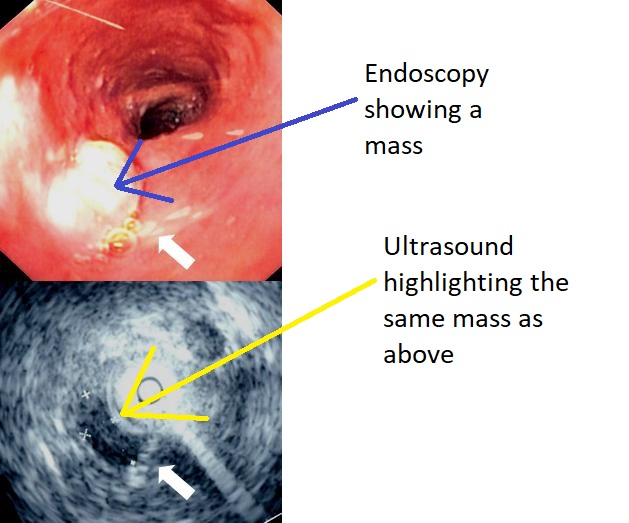Esophageal cancer echocardiography and ultrasound
Jump to navigation
Jump to search
|
Esophageal cancer Microchapters |
|
Diagnosis |
|---|
|
Treatment |
|
Case Studies |
|
Esophageal cancer echocardiography and ultrasound On the Web |
|
American Roentgen Ray Society Images of Esophageal cancer echocardiography and ultrasound |
|
Esophageal cancer echocardiography and ultrasound in the news |
|
Risk calculators and risk factors for Esophageal cancer echocardiography and ultrasound |
Editor-In-Chief: C. Michael Gibson, M.S., M.D. [1]; Associate Editor(s)-in-Chief: Hadeel Maksoud M.D.[2]
Overview
There are no echocardiography findings associated with esophageal cancer. However, an endoscopic ultrasound may be helpful in staging of esophageal cancer showing location, spread and resectability.
Ultrasound
- An endoscopic ultrasound (EUS) is the initial test used in staging esophageal cancer.
- It can be used to take a biopsy via esophageal ultrasound fine needle aspiration (EUS - FNA).
- EUS can determine the following features:[1][2][3]
- Location
- Degree of spread within the smooth muscle layers
- Regional lymph node spread
- Metastasis to organs
- Resectability
- Prognostically to determine remission
| Endoscopic Ultrasound[4] | Sensitivity | Specificity |
|---|---|---|
| Detection of celiac lymph nodes metastases | 85% | 96% |
| Detection of regional lymph node metastases | 80% | 70% |

References
- ↑ Flamen P, Lerut A, Van Cutsem E, De Wever W, Peeters M, Stroobants S, Dupont P, Bormans G, Hiele M, De Leyn P, Van Raemdonck D, Coosemans W, Ectors N, Haustermans K, Mortelmans L (2000). "Utility of positron emission tomography for the staging of patients with potentially operable esophageal carcinoma". J. Clin. Oncol. 18 (18): 3202–10. doi:10.1200/JCO.2000.18.18.3202. PMID 10986052.
- ↑ Keswani RN, Early DS, Edmundowicz SA, Meyers BF, Sharma A, Govindan R, Chen J, Kohlmeier C, Azar RR (2009). "Routine positron emission tomography does not alter nodal staging in patients undergoing EUS-guided FNA for esophageal cancer". Gastrointest. Endosc. 69 (7): 1210–7. doi:10.1016/j.gie.2008.08.016. PMID 19012886.
- ↑ Tio TL, Coene PP, den Hartog Jager FC, Tytgat GN (1990). "Preoperative TNM classification of esophageal carcinoma by endosonography". Hepatogastroenterology. 37 (4): 376–81. PMID 2210603.
- ↑ van Vliet EP, Heijenbrok-Kal MH, Hunink MG, Kuipers EJ, Siersema PD (2008). "Staging investigations for oesophageal cancer: a meta-analysis". Br. J. Cancer. 98 (3): 547–57. doi:10.1038/sj.bjc.6604200. PMC 2243147. PMID 18212745.